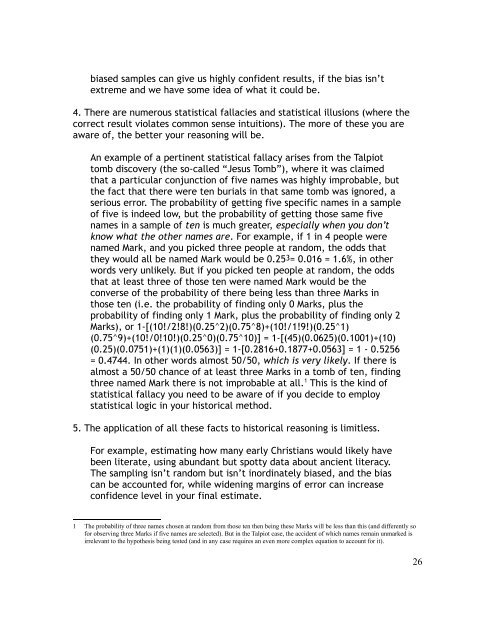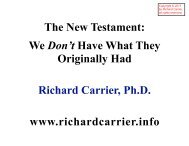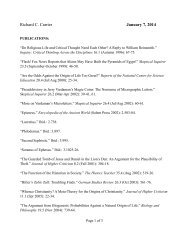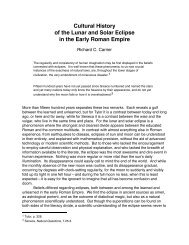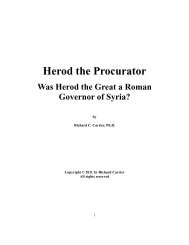“Bayes' Theorem for Beginners: Formal Logic and ... - Richard Carrier
“Bayes' Theorem for Beginners: Formal Logic and ... - Richard Carrier
“Bayes' Theorem for Beginners: Formal Logic and ... - Richard Carrier
You also want an ePaper? Increase the reach of your titles
YUMPU automatically turns print PDFs into web optimized ePapers that Google loves.
iased samples can give us highly confident results, if the bias isn’t<br />
extreme <strong>and</strong> we have some idea of what it could be.<br />
4. There are numerous statistical fallacies <strong>and</strong> statistical illusions (where the<br />
correct result violates common sense intuitions). The more of these you are<br />
aware of, the better your reasoning will be.<br />
An example of a pertinent statistical fallacy arises from the Talpiot<br />
tomb discovery (the so-called “Jesus Tomb”), where it was claimed<br />
that a particular conjunction of five names was highly improbable, but<br />
the fact that there were ten burials in that same tomb was ignored, a<br />
serious error. The probability of getting five specific names in a sample<br />
of five is indeed low, but the probability of getting those same five<br />
names in a sample of ten is much greater, especially when you don’t<br />
know what the other names are. For example, if 1 in 4 people were<br />
named Mark, <strong>and</strong> you picked three people at r<strong>and</strong>om, the odds that<br />
they would all be named Mark would be 0.253= 0.016 = 1.6%, in other<br />
words very unlikely. But if you picked ten people at r<strong>and</strong>om, the odds<br />
that at least three of those ten were named Mark would be the<br />
converse of the probability of there being less than three Marks in<br />
those ten (i.e. the probability of finding only 0 Marks, plus the<br />
probability of finding only 1 Mark, plus the probability of finding only 2<br />
Marks), or 1-[(10!/2!8!)(0.25^2)(0.75^8)+(10!/1!9!)(0.25^1)<br />
(0.75^9)+(10!/0!10!)(0.25^0)(0.75^10)] = 1-[(45)(0.0625)(0.1001)+(10)<br />
(0.25)(0.0751)+(1)(1)(0.0563)] = 1-[0.2816+0.1877+0.0563] = 1 - 0.5256<br />
= 0.4744. In other words almost 50/50, which is very likely. If there is<br />
almost a 50/50 chance of at least three Marks in a tomb of ten, finding<br />
three named Mark there is not improbable at all. 1 This is the kind of<br />
statistical fallacy you need to be aware of if you decide to employ<br />
statistical logic in your historical method.<br />
5. The application of all these facts to historical reasoning is limitless.<br />
For example, estimating how many early Christians would likely have<br />
been literate, using abundant but spotty data about ancient literacy.<br />
The sampling isn’t r<strong>and</strong>om but isn’t inordinately biased, <strong>and</strong> the bias<br />
can be accounted <strong>for</strong>, while widening margins of error can increase<br />
confidence level in your final estimate.<br />
1 The probability of three names chosen at r<strong>and</strong>om from those ten then being these Marks will be less than this (<strong>and</strong> differently so<br />
<strong>for</strong> observing three Marks if five names are selected). But in the Talpiot case, the accident of which names remain unmarked is<br />
irrelevant to the hypothesis being tested (<strong>and</strong> in any case requires an even more complex equation to account <strong>for</strong> it).<br />
26


